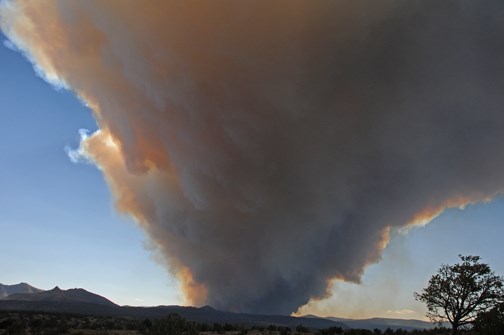
photo by sally king THE LAS CONCHAS FIRE The Las Conchas Fire began at approximately 1 PM on June 26, 2011 just west of the park. In its first 13 hours it burned over 44,000 acres or almost an acre a second. Over the next weeks it grew to over 156,000 acres and became the largest wildfire in New Mexico history. The fire started with a tree falling onto a power line. Once it began the extremely flammable vegetation from a record breaking dry year allowed the fire to grow quickly, pushed by strong winds toward the east and into the park. All the major watersheds within Bandelier were heavily impacted by the fire including Frijoles Canyon, where the visitor center and main visited archeological sites are located. Over 75% of Frijoles Canyon lay within the fire's footprint, much of it burned with high severity. Photos of Las Conchas Fire and its effects

photo by sally king THE FIRE'S EFFECTS With much of the vegetation removed and the ground vitrified in some areas where the fire burned extremely hot, fear of flash flooding in the park's canyons was a call to action. In the days just after the fire began important decisions had to be made. The night the fire began as many museum objects as could be carried were removed from the park museum. A park building used to store objects and historical papers and photos was protected by cutting up fire shelters and securing them over the buildings windows. The building was then slimed with a fire resistant material. A few days later as water replaced fire as the biggest threat to park resources a new plan was devised. The visitor center was surrounded by jersey barriers and over 14,000 sand bags. Visqueen, a water repellant material was placed over the outside walls of the historic CCC building. Bridges were removed from Frijoles Creek to prevent them from become damming mechanisms in the event of strong flood waters. The decision was made that for the time being for safety reasons Frijoles Canyon could not be occupied by employees, park residents, or visitors. FLOODING 
photo by sally king THE FUTURE The fire affected the park in numerous ways. Wildlife was killed or displaced. Watersheds became potential dangerous channels for raging flood waters. The park feared its most valuable assets might be lost. Visitors lost their ability to experience the magic that has long been Bandelier. As time passes, the park is beginning to slowly heal. Several sections of Bandelier reopened to the public on July 19, 2011. A shuttle into Frijoles Canyon operated for 35 days during late September and through October. With bridges removed 60% of parking located on the west side of Frijoles Canyon is unavailable. For the peak season of 2012 (April - October) decisions must be made as to how the park can best serve the public. The threat of severe flooding is not just a thing of the past. Even so as time passes wildlife is starting to reoccupy areas of the park recently impacted by fire. Some including turkey vultures and coyotes are flourishing as their food sources became more available. Others such as black bear may not come back to the park for quite some time. Some like Jemez Mountain salamanders and Goat Peak Pika may never be found in the park again. Research is underway to chart the progress of the recovery. Plants like oaks and lupines are sprouting/blooming within the fires perimeter. At the park we are seeing first hand that time heals all wounds. But we wonder, in a place etched by fire when will the park be affected by fire again. |
Last updated: April 28, 2025
